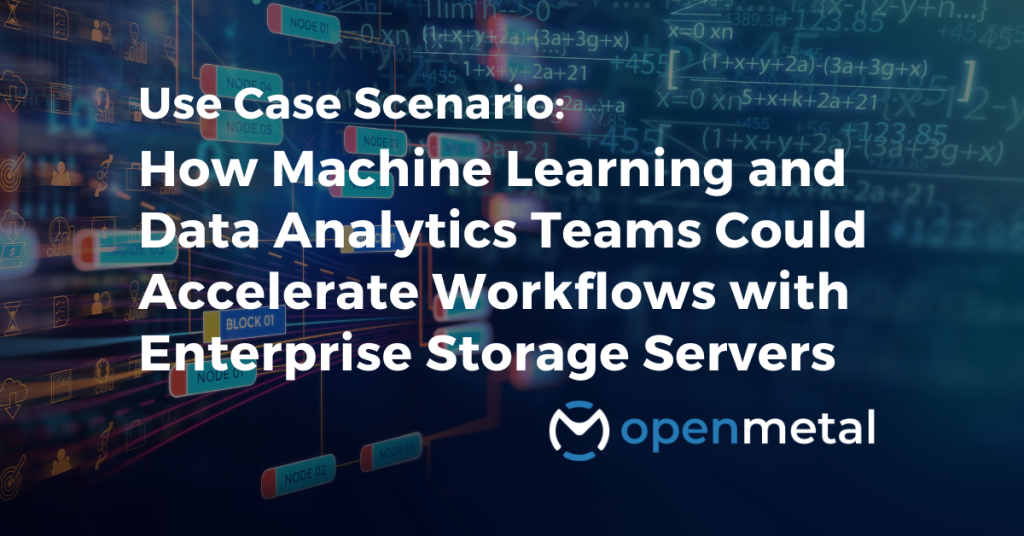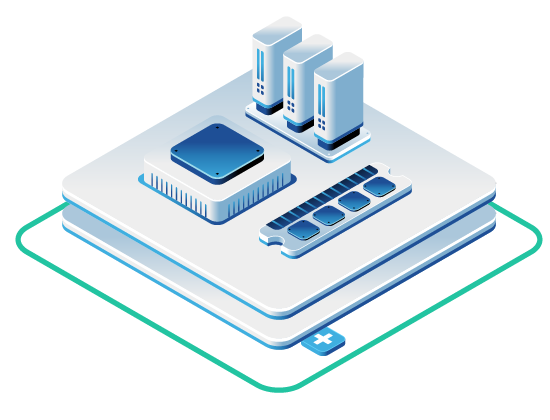
Whether training large-scale machine learning models, running inference pipelines, or processing massive data sets for real-time analytics, the underlying infrastructure must provide not only performance, but scale and reliability.
In this article we explore a possible infrastructure setup for ML and Data Analytics workloads with an OpenMetal Large v3 Cloud Core paired with a 3-node cluster of Storage Large v3 servers —offering hybrid storage, ample compute resources, and predictable networking.
The Infrastructure Challenge
Machine learning and analytics workloads demand:
- High-performance I/O for accessing training data, model weights, and logs
- Massive capacity for datasets, checkpoints, and long-term storage
- Fast, multi-threaded compute for model training, data transformations, and pipeline orchestration
- High memory availability to cache data and avoid frequent disk I/O
- Consistent bandwidth to support distributed teams, cloud integrations, or edge inferencing
OpenMetal’s infrastructure is designed to support teams operating at any scale—from research groups to production-level MLOps teams.
Example Infrastructure Architecture for ML & Analytics Workloads
1. Optimized Cloud Core + Storage Architecture
One possible infrastructure scenario for machine learning and analytics workloads could include:
- 1x OpenMetal Large v3 Cloud Core:
- 2x Intel Xeon Gold 5416S (32 cores / 64 threads @ 2.0GHz base / 4.0GHz turbo)
- 512GB DDR5 4400MHz RAM
- 2 × 6.4TB NVMe SSDs (12.8TB total) for fast orchestration, management, and VM hosting
- 960GB Boot Disk
The Cloud Core manages orchestration, virtualization, and control plane workloads. Its high clock speeds, DDR5 memory, and ultra-fast NVMe drives make it well-suited for supporting real-time control of compute and storage clusters, container orchestration (e.g., Kubernetes), and deployment workflows.
- 3x Storage Large v3 Servers:
- 2x Intel Xeon Silver 4314 (32 cores / 64 threads @ 2.4GHz base / 3.4GHz turbo)
- 256GB DDR4 3200MHz RAM per server
- 4 × 4TB Micron 7450 MAX NVMe SSDs (16TB total per node)
- 12 × 16TB HDDs (192TB raw per node / 576TB total)
- 512GB Boot Disk
This potential configuration would deliver high availability, balanced performance, and more than half a petabyte of highly redundant, high-throughput storage—well-suited to meet the needs of demanding ML and analytics environments.
2. NVMe Acceleration for Real-Time Model Work
Each storage server includes 16TB of NVMe SSD storage using Micron 7450 MAX drives—ideal for low-latency, high-IOPS access to:
- Training datasets
- Embeddings and vector stores
- Model checkpoints and hyperparameter logs
- Real-time inference workloads
This layer supports accelerated model training, quick iteration cycles, and responsive model deployment pipelines.
3. High-Capacity HDDs for Long-Term Storage
The 12x16TB HDDs per node (576TB raw total across the cluster) provide ample room for:
- Raw training data (images, telemetry, clickstreams, etc.)
- Backup snapshots and model archives
- Historical analytics data
With Ceph clustering, data is replicated and balanced automatically to ensure durability and performance.
4. Ample RAM for In-Memory Processing
Each node in the storage cluster includes 256GB of DDR4 3200MHz RAM, providing:
- In-memory caching of transformed datasets and intermediate outputs
- Reduced disk I/O for memory-intensive analytics and feature engineering
- Support for large Spark or Dask operations across pipelines
Combined with the Cloud Core node’s orchestration power, teams can efficiently run distributed compute workloads.
5. Multi-Core CPUs for Parallel Training and Processing
Each Storage Large v3 server features 64 threads, allowing:
- Concurrent training across multiple experiments
- Parallel ETL, inference, and streaming analytics pipelines
- Efficient containerized workloads (e.g., TensorFlow Serving, PyTorch Lightning, MLflow)
This makes the infrastructure suitable for CI/CD-style ML pipelines and scalable analytics platforms.
6. High Bandwidth for Data Movement and Collaboration
- 20Gbps internal networking enables fast communication between compute and storage nodes.
- 2Gbps public uplinks per server support streaming to and from external services, collaborators, or model consumers.
Whether syncing models to edge devices, serving real-time inference, or delivering dashboards to global teams, network performance is reliable and scalable.
Predictable Egress Pricing for Data-Heavy Workflows
Machine learning workloads often involve large data transfers—from ingesting raw training data to exporting model results. OpenMetal’s 95th percentile egress pricing eliminates the unpredictable costs of traditional cloud models. Spikes in usage, such as during model rollout or batch exports, are excluded from billing. This transparent pricing model:
- Encourages experimentation without financial penalty
- Supports seasonal or burst-driven pipelines
- Allows budgeting with confidence, especially for production workloads
Why This Matters for ML & Analytics Teams
- Accelerate training and inference with low-latency NVMe storage
- Support large datasets and model history with 576TB of high-capacity HDD storage
- Run multiple workloads simultaneously using high-thread-count CPUs and large memory pools
- Deliver fast, distributed collaboration and deployment across secure high-bandwidth infrastructure
- Avoid surprise billing with cost-predictable bandwidth policies
From early experimentation to full-scale deployment, OpenMetal’s infrastructure gives machine learning and data analytics teams the control, speed, and efficiency they need to move faster and smarter.
Ready to see how OpenMetal can supercharge your ML workflows?
Contact our team to explore our storage-optimized server configurations.
Interested in the OpenMetal IaaS Platform?
Hosted Private Cloud
Day 2 ready. No licensing costs. Delivered in 45 seconds. Powered by enterprise open source tech.
Bare Metal Servers
High end bare metal server hosting for virtualization, big data, streaming, and much more.
Consult with Our Team
Meet our experts to get a deeper assessment and discuss your unique IaaS requirements.


































